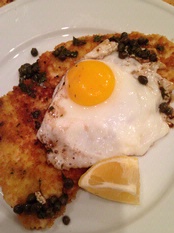WINE WITH…Pork Schnitzel a la Holstein
In our opinion this delicious retro dish is ready for a comeback. Wiener Schnitzel traveled from Italy (think Veal Milanese) to become the national dish of Austria, but while Wiener Schnitzel is made with veal, the word “schnitzel” simply describes a boneless piece of meat–veal, chicken, ham, pork–that’s pounded into thin scallops, then breaded and fried. There are infinite variations on the theme: Schnitzel Cordon Bleu (with ham and cheese layered into the veal); Kãseschnizel (Kãse is cheese—think of it as a sort of schnitzel melt); Jagerschnitzel (topped with mushroom sauce); Schnitzel with cream sauce and so on. We have no idea why this rendition is named “Holstein”, but for us, it is the most interesting and complex of all the schnitzel dishes. It has salty/briny elements thanks to anchovies and capers, a tangy splash of lemon, and a softly fried egg that creates its own sauce as the yolk flows across the meat.
interesting and complex of all the schnitzel dishes. It has salty/briny elements thanks to anchovies and capers, a tangy splash of lemon, and a softly fried egg that creates its own sauce as the yolk flows across the meat.
Timing is essential in preparing this dish since everything takes place more or less at the last minute. The meat may be pounded several hours in advance, but for beautifully crisp results don’t add the flour coating until shortly before cooking. It’s important to have the capers, parsley, anchovies and lemon juice already assembled together in a small bowl ahead of time so that the mixture can be tipped into the hot skillet just before serving. You may use whatever type of breadcrumbs you like, but we’ve found commercial Panko crumbs give notably light and crisp results. Lard is the traditional frying fat, but we use a mix of butter and olive oil instead.
Since this dish is both delicate and rich, don’t go overboard with complicated side dishes (save the red cabbage and dumplings for a schnitzel with less intricate flavors).
Pork Schnitzel a la Holstein
(serves four)
4 boneless pork cutlets, about 6 oz each
Salt and pepper
2 tablespoons minced parsley
1 tablespoon capers
¼ cup fresh lemon juice
freshly ground black pepper
1 cup flour
5 eggs
1 ½ cups bread crumbs, preferably Panko
About 4 tablespoons olive oil
About 4 tablespoons butter
Using a meat mallet or the edge of a sturdy plate pound, the cutlets until they are about 1/4 to 1/8 inch thick. Season lightly with salt and pepper and set aside. In a small bowl mix together the parsley, capers, lemon juice and black pepper. Reserve.
When you are ready to cook the cutlets, put the flour in a plastic bag. Beat one of the eggs in a medium sized bowl. Put the breadcrumbs on a large plate or other flat surface. Begin heating a large, sturdy skillet (cast iron is perfect) over medium high heat.
Place the pork cutlets in the bag of flour and shake it, making sure both sides of each cutlet are lightly coated. Next, dip each floured cutlet in the beaten egg, then in the breadcrumbs. Put 2 tablespoons olive oil and 1 tablespoon butter in the heated pan, and as soon as the butter has melted add the meat in a single layer (you may have to work in batches, adding more oil and butter as necessary). Cook the pork for only 4-5 minutes, turning the cutlets until they are nicely browned.
Transfer the schnitzels to individual serving plates. Add another drizzle of oil to the skillet and fry the eggs sunny side up (do not overcook—the yolks should remain very soft). Top each serving of schnitzel with an egg. Quickly wipe out the bottom or the skillet with a paper towel, add another tablespoon each of olive oil and butter, and swirl in the caper mixture, stirring until it is warmed. Spoon it over the schnitzel. Serve with a wedge of lemon on each plate.
|
Selection
|
Approx. Price |
Comments |
|
J. Lohr, Paso Robles (California)“ Gesture” 2013
|
$30
|
A Rhône-style blend of Rousanne, Grenache Blanc, and Viognier, this wine is fleshy and full-bodied, with some sweetness from its ripe fruit, but also a floral accent that adds interest. It has just the right weight and texture to marry well with this dish. |
|
Dr. Loosen, Mosel (Germany) Riesling Kabinett “Bernkasteler Lay” 2012(Imported by Loosen Bros. USA)
|
$28 |
Lighter in body than the California white, this German beauty nonetheless very much held its own with our schnitzel. Though a kabinett, it definitely is on the sweet side, with flavors that echo summer fruits and golden delicious apples. Its razor sharp acidity keeps everything in check, and is what made it so appealing at the dinner table.
.
|
|
Nobilo, Marlborough (New Zealand) Pinot Noir “Icon” 2013 (Imported by Constellation Imports)
|
$22 |
A light, lithe Pinot Noir, with dark cherry fruit and a silky texture, this wine offered plenty of flavor but no astringent or harsh character. Its brightness on the palate made us eager for both another sip and another bite.
|
|
Famille Perrin, Vacqueyras (France) 2011 (Imported by Vineyard Brands)
|
$32 |
Deeper and more lavish than the Kiwi Pinot, this southern Rhône delight tastes of fruit bathed in summer sunshine. It was almost too heavy to pair well with the schnitzel, but its carefree vibrancy made the match work. |
|
Schramsberg, California Blanc de Noirs 2010
|
$40 |
A Champagne-styled sparkler with schnitzel? Well, why not? The bubbles in this wine gave it a vivacious character when paired with the dish, leading both of us to keep returning to it again and again. Especially now, as we all move into the holiday season, it’s worth remembering how delicious good sparkling wine can be with food.
|
